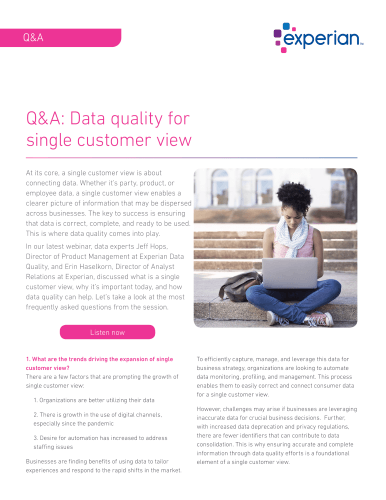- Products

Enjoy a free 30-day trial of our
data validation software.Experience the power of trusted data
solutions today, no credit card required! - Solutions

Enjoy a free 30-day trial of our
data validation software.Experience the power of trusted data
solutions today, no credit card required! - Partners

Enjoy a free 30-day trial of our
data validation software.Experience the power of trusted data
solutions today, no credit card required! - Learn more
- Pricing
- Contact Us
FAQ Data quality for single customer view
At its core, a single customer view is about connecting data. Whether it’s party, product, or employee data, a single customer view enables a clearer picture of information that may be dispersed across businesses.
The key to success is ensuring that data is correct, complete, and ready to be used. This is where data quality comes into play. In our latest webinar, data experts Jeff Hops, Director of Product Management at Experian Data Quality, and Erin Haselkorn, Director of Analyst Relations at Experian, discussed what is a single customer view, why it’s important today, and how data quality can help. Let’s take a look at the most frequently asked questions from the session.
1. What are the trends driving the expansion of single customer view?
There are a few factors that are prompting the growth of single customer view:
- Organizations are better utilizing their data
- There is growth in the use of digital channels, especially since the pandemic
- Desire for automation has increased to address staffing issues
Businesses are finding benefits of using data to tailor experiences and respond to the rapid shifts in the market. To efficiently capture, manage, and leverage this data for business strategy, organizations are looking to automate data monitoring, profiling, and management. This process enables them to easily correct and connect consumer data for a single customer view.
However, challenges may arise if businesses are leveraging inaccurate data for crucial business decisions. Further, with increased data deprecation and privacy regulations, there are fewer identifiers that can contribute to data consolidation. This is why ensuring accurate and complete information through data quality efforts is a foundational element of a single customer view.
2. Single customer view, customer 360, universal view, golden record, identity resolution, how do they all tie together?
We find that these terms, with the exception of identity resolution, are variations of the same meaning. Their definitions describe the concept of connecting data across different sources and creating a single source of truth.
Let’s start with identity resolution. This is different than a single customer view. Identity resolution is the concept of confirming the identity of an individual, this can help prevent fraud because the individual is being verified as a real person that is providing truthful information.
A single customer view, also known as customer 360 or a universal view, is the concept of pulling data together across multiple sources to get a complete view of a customer. It’s crucial to consider that this is an evolving process that changes based on the given use case, and where data quality is of the upmost importance.
A golden record is the concept of creating one source of truth for an account that can be used across an organization. This is taking the single customer view to the next level and provides confidence in that customer record for targeted marketing, consumer trend reports, upsell opportunities, and more.
3. Why is a single customer view so important?
On average, U.S. organizations manage upwards of 19 databases. And on top of managing an extensive number of data sources, the information is continuously evolving. Similar to how we must be agile in our business operations, we must also be flexible in how we pull data together.
Businesses are already combining and consolidating data, even though they may not refer to it as single customer view. This step is usually necessary for different activities across the business, whether it’s marketing, finance, or operations. However, we are finding that this is not a one-and-done project. To sustain agility, it is critical to ensure data is consolidated, organized, and managed on an ongoing basis. Businesses find that a single customer view also benefits operational efficiency, improved customer experience, and strategic decision-making.
4. What data-related challenges are organizations facing today?
When it comes to building a single customer view, organizations realize that data quality, privacy risk and regulations, and data collection methods are the biggest challenges.
- Data inaccuracy – 85% of organizations say poor-quality contact data negatively impacts processes and efficiency. Data quality is essential to ensure accurate and complete information, especially when it comes to pulling disparate sources of information together.
- Consumer privacy – These days, consumer privacy preferences and regulations are everchanging. Consumer privacy and data security should be of upmost importance when collecting and managing data.
- Data collection – Before creating a single customer view, it’s best to first determine the reason behind collecting and consolidating the data. Once the objective is clear, this can direct and refine the strategy to fit the purpose.
A single customer view is meant to be fit for purpose and can range across various data types. The goal is to be agile, and that’s why it’s important to be focused on how the information is being pulled together and why that single view is important for the task.
